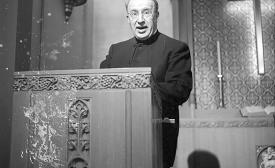Swiss forgive, don’t forget
It took about 490 years for government officials in Bern, Switzerland, to ask for forgiveness for persecution of Anabaptists in the region. It took less than two to get a response from Swiss Mennonites.
It took about 490 years for government officials in Bern, Switzerland, to ask for forgiveness for persecution of Anabaptists in the region. It took less than two to get a response from Swiss Mennonites.
“Reformed and Anabaptist are branches from the same tree,” said Hanspeter Jecker, a Mennonite theologian from Switzerland. “Anabaptist convictions that once were controversial—such as the voluntary nature of church membership and rejection of capital punishment—are now accepted by many Christian groups.
More than 30 people from 12 countries gathered at Goshen College on June 17-19 to talk about gathering and preserving the sources that are crucial to the history of the global Anabaptist-Mennonite church.

Some members of the seventh Mennonite World Conference Presidium, held in Kitchener, Ont., from Aug. 1 to 7, 1962. Pictured from left to right: Paul Showalter of Germany; Hendrik W. Meihuizen of the Netherlands; Erland Waltner of Elkhart, Ind.; Peter Wiens of Paraguay; Harold S. Bender of Goshen, Ind.; and Jesse B. Martin of Kitchener. (David L. Hunsberger / Mennonite Archives of Ontario photo)

Harold S. Bender of Goshen, Ind., speaking at the Church and State study event, which he chaired. The event, held in 1957 at Chicago Temple Methodist Church, was sponsored by the Mennonite Central Committee Peace Section. (The Canadian Mennonite / Mennonite Archives of Ontario photo )
As a minister of the Mennonite church in Danzig (now Gdansk, Poland), Hermann Gottlieb Mannhardt knew how to challenge and encourage his congregants in matters of faith and moral conduct. He also knew how to energize a crowd in matters related to politics and patriotism.
Every year on the Sunday closest to January 21, Mennonite World Conference (MWC) invites its 107 member churches to join in a celebration of World Fellowship Sunday. (See the 2019 worship resources here.)
At Bluffton (Ohio) University’s Musselman Library, archivist Carrie Phillips stores seven copies of the 1748 edition of the Ephrata Martyrs Mirror in boxes specially designed to keep them preserved. But this year, Phillips had multiple opportunities to take the books off the shelf and showcase both their religious and historical significance during presentations on and off campus.
Martyrs Mirror is newer than the Bible and longer than some copies of it.